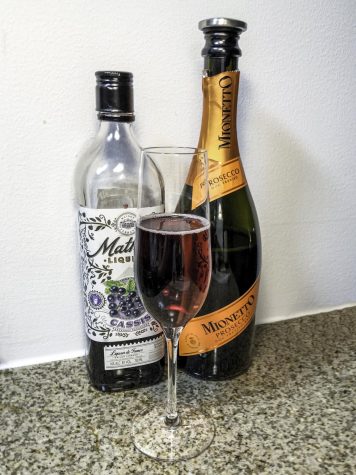Spoil yourself and impress your friends with a refreshing spritz
You can feel like a champagne drinker without breaking the bank by learning to augment sparkling wine with a colorful, flavorful cordial or bitters.
February 28, 2022

Every New Year’s Eve, my parents would give me a glass of champagne. I started to like the flavor when I was 17 or 18. Once I was old enough to buy booze myself, I tried becoming a champagne drinker. Imagine my surprise when all the good sparkling wines cost $50 for a bottle, and all the wines I could afford tasted like Welch’s sparkling grape juice!
The solution is to mix affordable wine with something strong enough to mask the flavor. Enter the spritz — a sparkling white wine mixed with bitters or practically anything else.
Before I go any further, I’d like to ward off any potential criticism. Historically, and as defined by the International Bartender’s Association, a spritz is made specifically with a bitter digestif (an after-dinner drink), and if you mix sparkling white wine with fruity cordials, you have a different drink. The distinction is somewhat foolish, especially since the line between bitters and cordials is actually somewhat fluid, so when I say “spritz,” I mean sparkling white wine augmented with something else alcoholic.
I would explain the distinctions between our mixers to help you choose what you’ll like, but I can’t really do that for our sparkling wines. Unfortunately, I’m a drunk, not a sommelier. The best advice I can give on wine terms is to call it champagne if it’s from France, cava if it’s from Spain, or prosecco if it’s from Italy. If it’s from California, it’s just sparkling white wine. All white wines, and most rosés, should be drunk cold. Please don’t ask why, I just know that’s how you do it.
First, we need our base. Expect to spend between $10 and $15 on a bottle of prosecco (or prosecco-style Cali wine). No less, or it’ll be gross, unless it’s Costco’s Kirkland prosecco. Any more, and you’re wasting nice wine on a mixed drink. My gold standard mixing wine is Costco’s Kirkland brand prosecco, a smooth-tasting wine that costs $7 per bottle. Mionetto Prosecco ($13) is also an entirely unobjectionable option. Another reasonable choice is Barefoot Wines’ prosecco ($10). You can also go into any wine shop and say you want a bottle of prosecco for mixing, and they’ll know what you want.
Pro tip: When you buy your wine, ask if they have it chilled. Chilled wine helps elevate the flavor, aroma and crisp taste of the drink. If it’s a good wine shop, they will have a fridge in the back so they can give you a cold bottle of any of their white wines.
Next, we need something to mix with our wine to make it colorful and flavorful. Bitters are any alcoholic drink with a primarily bitter flavor. The classic choice is Aperol — a lovely orange-colored bitter that’s subtly sweet and cheap (about $28 for a 750ml bottle). I believe it’s profoundly impossible to describe the flavor of Aperol, but I’ve heard it called orange soda for grown-ups or “if rhubarb pie was liqueur.”
If you think Aperol is too sweet, switch to its older, more bitter sibling, Campari. Campari, a dark red apéritif (a before-dinner drink) that tastes kind of like orange peels. My dad swears by the Campari spritz, but honestly, it’s an acquired taste. I’ve never met anyone younger than 30 who liked it better than the Aperol version.
Cordials, on the other hand, are primarily sweet, usually fruit-flavored digestifs. The classic French spritz, popularized by the mayor of Dijon after World War II, is made with crème de cassis — a French cordial made with blackcurrants — or a blackcurrant liqueur. This drink is called a kir if you use still white wine, or a kir royal if you use champagne. If you use prosecco, I think the French would call it an abomination. Buy Mathilde brand cassis; it’s tasty without being overpriced.
If you want to get fruity, hunt around your liquor store’s cordials section for a liqueur that sounds appealing. I’ve had good experiences with Rothman & Winter’s apricot liqueur.
If you want something stronger, use gin. Be careful with this one, though; a gin spritz is much more alcoholic than you think, and the wine will cover it up. Don’t even bother unless you have a gin you think tastes good. A solid litmus test is whether you can take a sip of your gin neat without making a face. I’m always partial to floral gins and I think they’re a great choice for spritzes. Hendrick’s Midsummer Solstice is particularly fun, and I bet their Original, which has some cucumber flavor, would also make a great spritz.
Now, we mix! Spritzes are just about the most forgiving drink to mix. Pour a little bit of your liqueur or bitters into a glass, preferably a champagne flute — although a normal wine glass will work fine — and then add about three times as much sparkling white wine. If your ingredients are warm, add an ice cube. If you’re planning ahead, keep them in the fridge instead. Drop some berries in if you feel the need for a garnish.
Traditionally, you’d sip a spritz before dinner or over your appetizer course. I like them enough that I’ll drink them with dinner, at a Broadway show or while reading a book. The spritz is an easy, versatile drink, and now that I’ve started keeping prosecco in the fridge, I find there’s no end to the occasions when I’ll toss one together.
Happy spritz-ing! I promise we’ll get into complicated cocktails next time — I wanted to start with the easy stuff. Oh, and please drink responsibly.
Contact Phoebe Goldman at [email protected].
























































































































































Julia McNeill • Mar 12, 2022 at 9:39 pm
Kir royales are the best drink and very underrated; great article